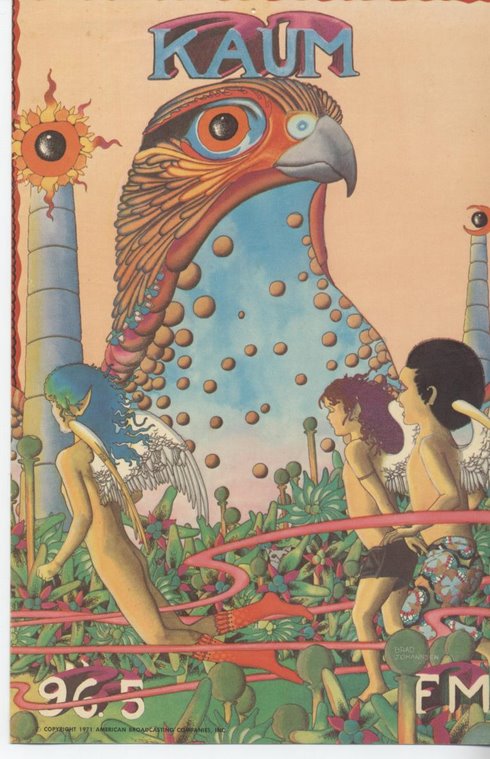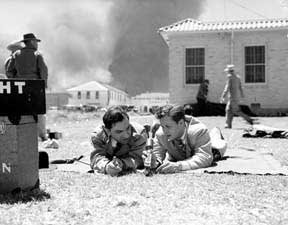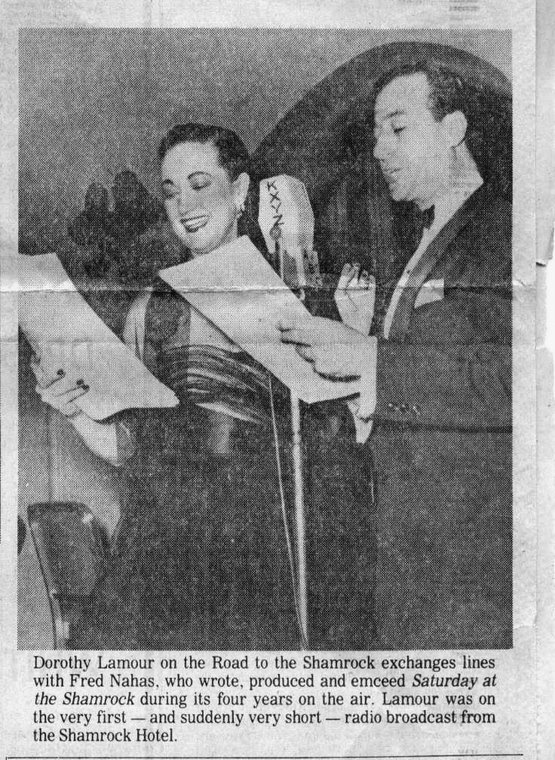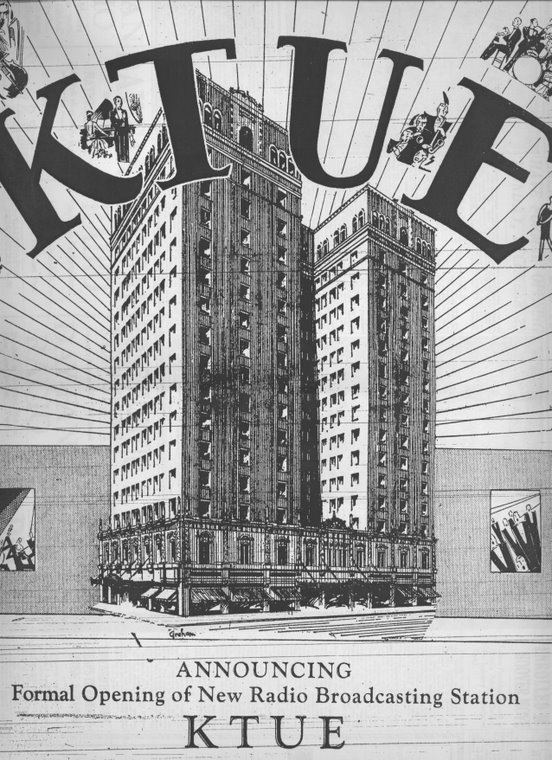This timeline includes information drawn principally from newspaper reports in Houston and Galveston with some data from the FCC databases available online. It has been brought down to ca. 1985 with information known at this time but there are many gaps in the available data.
10/8/47 - Houston hotel man W. Albert Lee files for a permit to operate a TV station in Houston on Channel 2 as KLEE-TV. The nearest TV station on the air at that time was KSD-TV in St. Louis. Proposed studios will be in the Sterling Building.
1/5/48 - KTRH applies for a permit to operate KTRH-TV on Channel 13, the 1st of 5 or 6 applicants for that channel.
1/17/48 Post p.1 - Texas Television applies for a permit to operate KTHT-TV on Channel 7, at that time allocated to Houston. Texas Television is the TV branch of Roy Hofheinz’s Texas Star Broadcasting which also operates radio stations in Houston, San Antonio, and Harlingen and has applications for radio stations in Dallas and NOLA.
1/21/48 The Houston Post reports on p.1 that KPRC and the Post have applied for a permit to operate KPRC-TV on Channel 4, at that time allocated to Houston. The proposed transmitter will be on City National Bank where KPRC-FM is located with a total height of 415'.
1/30/48 - The FCC approves the application of W. Albert Lee for KLEE-TV.
The Houston Post reports Harris Co. Broadcasting’s application to operate KXYZ-TV on Channel 13. The story notes a sale is pending of Harris Co. Broadcasting’s KXYZ-AM and FM to oil man Glenn McCarthy’s Shamrock Broadcasting but no hearings have been scheduled by the FCC.
9/30/48 - FCC Freezes new TV applications. The freeze is intended to last only 6 months but the issues needing to be resolved prove to be thorny and the freeze stretches to 3 and a half years during which time no new TV stations are authorized.
12/20/48 - first telecast of a test pattern at full power on KLEE-TV, Channel 2
1/1/49 - First day of KLEE-TV, Channel 2
5/23/1950 - FCC approves sale of KLEE-TV to the Houston Post Co. for $740.000.
6/1/1950 - Houston Post assumes ownership of KLEE-TV, Channel 2
6/11/1950 - A man climbs into a roped off area at Buff Stadium that serves as the TV booth and sits down beside play-by-play announcer Dick Gottlieb and keeps interrupting him. Gottlieb repeatedly tries to quiet the man who eventually pulls a gun and shoots himself. The director, informed by a cameraman what has happened, asks to see it and the carnage is shown on screen for a few seconds. The man dies on the way to a hospital. Gottlieb is shaken but not hurt and the game and broadcast continue.
7/3/1950 - KLEE-TV call letters changed to KPRC-TV
11/2/50 - Press 3/33 - The Houston Press reports there may be 4 more TV stations in Houston; there are 4 applications for 3 UHF channels (23, 29, 39).
Fall 1951 - AT&T announces it has completed installation of coaxial cable from Houston to Dallas and will be ready to bring live network programming to Houston as soon as it gets to Dallas; in the meantime, the cable is carrying 600 phone circuits and Houstonians are watching TV shows as much as 6 weeks after they were originally broadcast by the networks. AT&T was under pressure from the 4 TV networks to get the whole nation connected to live TV in time for the national political conventions in the summer of 1952 and is working on a microwave link from Kansas City to Dallas.
4/14/52 - TV Freeze lifted
7/1/52 - Live TV network connection is completed for Houston. Work on the Kansas City to Dallas link has lagged and AT&T cobbles together a microwave-coax link from Jackson, Mississippi, to Dallas instead. The first network program seen live in Houston was the Today show with Dave Garroway who welcomes new viewers in Dallas, Fort Worth, Houston, New Orleans, Oklahoma City, San Antonio and Tulsa with the words “We’re in New York. We’re real people - just like the ones in your town.”
8/20/52 - A construction permit is issued for KUHT-TV to operate on Channel 8.
3/22/1953 - Gulf Television Co. Inc., signs on KGUL-TV, Channel 11, with studios at 11 Video Lane in Galveston. In its story on the new station the Chronicle mentions that permits have been issued for 8, 39, and 23 but notes the permittee for channel 23 reports having trouble getting his hands on any equipment.
3/29/53 - KPRC-AM/FM/TV moves into new studios on Post Oak Rd.near the present day Williams Fountain and boosts power from 16,000 to 65,000 watts and will further increase power to 100,000 watts when a new tower completed.
5/25/53 - KUHT-TV Signs on. The station has an excellent history on its website to which I can add nothing.
Late August, 1953, Frank Stockton, enjoying a day on the links, overhears his caddy entertaining fellow caddies by singing to them. He gets the boy’s number and calls KPRC-TV.
9/2/53 - 13 year old John Nash, Jr., a student at Jack Yates Jr. High, makes his TV debut on Matinee on KPRC-TV as a special guest of Dick Gottlieb. Described as a ‘real gone singer’ by one newspaper writer, Johnny Nash quickly becomes a regular on the program.
9/10/53 - Roy Hofheinz announces the entire KTHT staff is taking TV courses at KUHT so as to be prepared when the application for KTHT-TV is approved; KXYZ-FM leaves the air for 8 years, Fred Nahas, President and GM, says the entire staff will be devoted to getting their UHF TV station (29) on the air in the first quarter of 1954
9/12/53 - installation of a second coaxial cable serving Houston-Galveston is completed and in service. Up until that time, channels 2 and 11 had been sharing one link and had to work out agreements between themselves as to who would be allowed to take a live network feed and who would have to air kinescopes, films or live, local programming.
10/8/53 - KGUL-TV airs a special experimental program demonstrating CBS’ Colortron tube, seen only in black and white in Houston since the coaxial cable could not transmit color.
10/18/53 - Fred Nahas claims plans are complete and a site is to be announced soon for Ch. 29; the construction deadline is Feb 1954. (When Glenn McCarthy took over Harris County Broadcasting he had decided to withdraw from the competition for Channel 13 and attempt to get another station on the air sooner by going for a UHF permit)..
Ch. 23 - Dallas applicant Max Jacobs UHF Television Co. of Dallas, has until 1/1/54 to start construction on Channel 23.
10/22/53 - Thursday, 7pm, KNUZ-TV, Channel 39 signs on; owned by Veterans Broadcasting with studios on Cullen @ Wheeler in a building leased by the University of Houston. The station carries programs of the Dumont Network and is on the air 8 hours a day from 3-11pm. After the first day’s broadcasts, the station is off the air for four days while engineers work to resolve technical problems.
1/8/54 - Jesse Jones announces that after intense negotiations which started in November, 1953, the rival applicants for Channel 13 have merged to form Houston Consolidated Television which will become the only applicant for Channel 13. Jones declares it the 'greatest civic achievement in Houston in many years.' It is estimated the merger would save 2 years in the process of competitive hearings that would eventually decide a licensee.
The merger consists of KTRH Broadcasting Co. which holds 32% and will operate the station; Houston Area TV Co, consisting of 17 shareholders, who hold 32%; Houston TV Co., consisting of 15 shareholders who hold 20%; and TV Broadcasting Co. Of Houston (Roy Hofheinz), who holds 16%. The station will be affiliated with the Chronicle and could be on the air in 100 days.
A 5th applicant for Channel 13, W. C. Lechner, a Dallas oilman, had dropped out of the competition
1/14/54 - KGUL announces a deal has been signed for Houston studios in the Prudential Building on Holcombe Blvd. at Fannin (the building is now part of the MD Anderson Center complex).
5/3/54 - Post - KPRC-TV - 1st Color TV show, the Voice of Firestone from the network It is estimated there are only 50 or 60 color sets in the area, all but 2 or 3 still in the hands of distributors and retailers, some of whom will have public showings while others with invite guests. Color set screens are about 12 and a half inches and the sets cost $1000.
6/25/54 - Last day of KNUZ-TV; KTRK may take over studios and equipment to get on the air quicker.
Sometime in 1954, Houston Consolidated Television filed a petition with the FCC to restrict the Houston activities of KGUL-TV
10/1/54 - KGUL responds to KTRK petition to restrict Houston activities
Late 1954 - hearings were conducted before the FCC on KTRK’s charges that KGUL-TV was trying to move to Houston.
12/8/54 - Paul Taft, President and General Manager of KGUL-TV, testifies in the FCC hearings that the KGUL-TV permanent studios at Galveston occupy 945 square feet while the branch studios and offices in the Prudential building on Holcombe occupy 4000 square feet.
11/5/54 - KGUL files to delay approval of Channel 13 until the hearing is resolved on KGUL’s new tower.
11/20/54 - KTRK-TV Sign on
7/11/56 - FCC approved sale of KGUL-TV, Channel 11, by Gulf Television Corporation from Paul E. Taft and Associates for $4.75 million. Gulf Television is Corinthian Broadcasting Corporation.
3/28/57 - FCC approves sale of KXYZ-TV, Channel 29 (since deleted) by Milton R. Underwood and Philip R. Neuhaus from Glenn McCarthy for $600k (with KXYZ-AM).
June 59 (per Wikipedia) KGUL-TV becomes KHOU-TV
10/21/59 - Channel 11 sold by Corinthian Broadcasting to Whitney
Communications Corp, JH Whitney, US Ambassador to Great Britain.
April 24, 1960 - (per Wikipedia) - KHOU-TV begins broadcasting from new facilities at 1945 Allen Parkway, west of downtown Houston. The station will operate from that facility for 57 years before deciding to move due to damage sustained during Hurricane Harvey in 2017.
10/13/1965 - FCC approves purchase of 80% of the Construction Permit for Channel 39 (KNUZ-TV) from Max Jacob and Irvin Schenker (40% each) and Dave Morris (20%) by WKY Television Systems, Inc., for $240K.
KHTV-TV - 1/6/67, Channel 39
6/16/67 - FCC approves sale of KTRK-TV, Channel 13, from Houston Consolidated Television to Capital Cities Communications for $21.3M.
Ann Hodges column in the Chronicle, 11/20/67, announces KVVV-TV, channnel 16, Alvin due to be on the air early in 1968.
Broadcasting Yearbook, 1968, reports KJDO-TV, Channel 45, Rosenberg, has a target date of Fall, 1968, licensed to D.H.Overmyer Co., with sale to US Communications Corporation pending FCC approval. The same source reports KVVV-TV, Channel 16, licensed to KTUE Associates, Inc., has an unknown target date and KUAB-TV, Channel 20, licensed to United Artists Television, Inc., has an unknown target date.
According to Broadcasting Yearbook, 1971, KVVV-TV, Channel 16, Galveston, was approved by the FCC on March 18, 1968, with 977 Kilowatts visual, 100 Kilowatts Aural. The mailing address is TVUE, 1217 Prairie, Houston, consisting of Roy O. Beach (16%), Harris Kempner Trust (11%), and others. Jeff Thompson is listed as News Director.
August 31, 1969 - KVVV-TV (channel 16) leaves the air after a brief life of just 18 months on the air. The equipment and tower used by KVVV were eventually sold to new PBS member station in Corpus Christi, KEDT, which signed on in 1972.
Broadcasting Yearbook, 1971, reports KJDO-TV, Rosenberg, Channel 45, has a target date of April, 1972, to operate with 1,410 KW visual, 282 KW aural. The address is given as 1529 Walnut Street, Philadelphia, PA, % US Communications of Texas, US Communications Stations. The Chief Engineer is James Parker.
August 15, 1971 - KVRL-TV, Channel 26 signs on at 6pm; the station will operate weekdays starting at 4pm, Saturdays at 11:30am. The station became KDOG-TV sometime in the 1970s and as of May, 1978, when Metromedia purchased the station, KRIV-TV. The call letters were based on the initials of a company executive.
By publication deadline, the Broadcasting Yearbook, 1971, reported that KVRL-TV was not on the air and no target date had been set. It was licensed to Crest Broadcasting to operate with 1660 KW visual, 331 KW aural. Crest Broadcasting consists of Bernard Calkins, former head of the Houston City Bus Company, 25%, R. G. Schindler, 28%, and Leroy J. Gloger, owner of KIKK-AM/FM, 19%.
Broadcasting Yearbook, 1975, reports that Crest Broadcasting, 3935 Westheimer, licensee of KVRL-TV, consists of Raymond G. Schindler, 43%, Frank Head, 12%, and Leroy J. Gloger, 7%.
Broadcasting Yearbook, 1977, reports that Crest Broadcasting is the licensee of KDOG-TV, Channel 26. Leroy J. Gloger is President and General Manager, still owning only 7%. The same source reports an application for a subscription TV service to operate on Channel 20 by a company based in Austin.
April 6, 1978 - FCC approves sale of KDOG-TV, Channel 26, from Crest Broadcasting to Metromedia for $11 M. The call letters are switched to KRIV-TV.
Channel 20 was licensed to operate as KEON-TV as of 10/27/1980. As of 11/16/1981 the call letters were switched to KTXH-TV but the exact sign-on date is not clear. Broadcasting Yearbook for 1985 gives only the year 1982, licensed to Channel 20 Inc, 8950 Kirby Drive, with 5000 kw visual, 500 kw aural.
11/17/83 - The FCC approves transfer of Corinthian Broadcasting's KHOU-TV to Belo Broadcasting for $342 M, part of a $606 M deal involving several Corinthian stations. The licensee remains Gulf Television.
12/31/84 - The FCC approves transfer of KTXH-TV, Channel 20, to Houston GBS Corporation, part of the Gulf Broadcast Group, for $62.07 M plus a prorated bonus related to first year operating profit.
The 1985 edition of Broadcasting Yearbook reports KHBU-TV, Channel 14, is licensed to Educational TV of Houston at 7502 Fondren Rd. and has a target air date of 1985. It also reports KZEI-TV, Channel 67, Alvin has been authorized to operate with 3000 kw maximum, 1352 kw horizontal visual and 1352 kw aural, licensed to Four Star Broadcasting, not yet on air and target date unknown.
The 1985 Broadcasting Yearbook reports there are 3 pending applications for Channel 57, Baytown, 10 for Channel 45, 4 for Channel 49 and 6 for Channel 55, all Conroe, 1 for Channel 22 and 2 for Channel 48, both Galveston, 8 for Channel 61, Houston, and 3 for Channel 51, Katy.


























